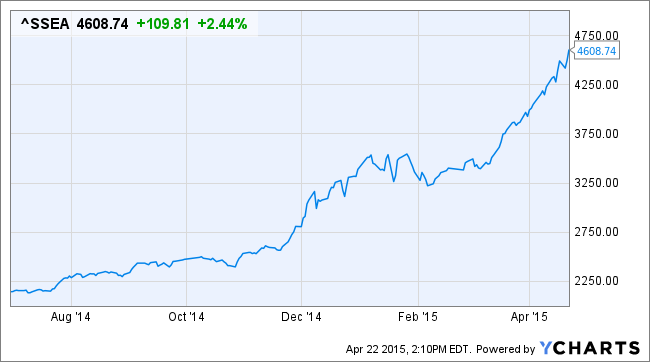When $5.3 trillion of government debt trades at negative interest rates in today’s fiscally profligate world it is a thundering tell. What it signifies is nothing less than financial regime change. There are no markets left in any meaningful sense of the word—–just a raging casino infected with the madness of the herds and the central bank pied pipers who intoxicate them.
Every day there are new confirmations of the mania. Last night, for instance, the Shanghai stock market closed up another 2.4%, meaning that it is now 114% above its level of just 9 months ago!

Â
^SSEA data by YCharts
And what has transpired in the land of red capitalism during that parabolic move? Why everything has gone virtually straight south because the most fantastic credit bubble in recorded history is beginning to burst. That is, notwithstanding Wall Street’s sell side propaganda, China’s vaunted $10 trillion GDP is not capitalist GDP in any familiar or meaningful sense; nor is it the product of organic market-based economic growth.
Instead, it is “constructed GDP†which has been fabricated out of centrally issued and allocated fiat credit. Over the past two decades the People’s Printing Press of China issued virtually unlimited bank reserves in the process of buying up dollars to peg the RMB exchange rate in support of its national policy of export mercantilism. This, in turn, has enabled China’s total public and private credit outstanding to soar from $2 trillion at the turn of the century to $28 trillion today.

In short, the overlords of red capitalism in Beijing caused the entire nation to borrow itself silly in order to fund a construction and investment mania that has no historical parallel. Indeed, the 14X explosion of debt in 14 years has resulted in not only trillions of artificial “printing press GDPâ€, but, more importantly, in a stupendous accumulation of over-valued and uneconomic “assetsâ€Â on both public and private accounts.
There are currently an estimated 70 million empty high rise apartment units in China, for example, because under the baleful influence of unlimited credit these apartments were built for asset appreciation, not occupancy. In fact, most of China’s tens of million of punters who have invested in these units have taken pains to keep them empty and spanking new; like contemporary works of art, appreciation potential can be impaired by damage and scrapes.
Needless to say, there is a huge problem when you turn rebar, concrete and wallboard into tulip bulbs. Namely, when the price mania finally stops, not only do the speculators who put their savings into empty apartment units get crushed, but, more importantly, demand for new units quickly evaporates, causing an devastating contraction up and down the building supply chain.
There is no doubt that the sucking sound to the south presently being heard by the suzerains in Beijing is the construction supply chain collapsing—-even as they desperately and almost randomly hop from “tightening†to “loosening†money maneuvers on a daily basis. But housing prices are now heading down for the count and the upstream supply chain is visibly deflating.

